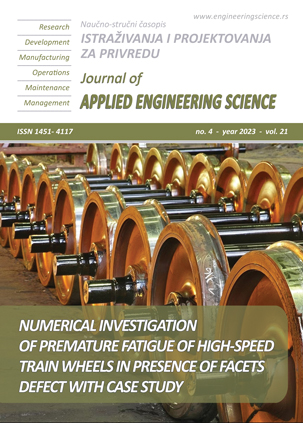DEFINING TERMINALS` EFFICIENCY IN A SEAPORT USING DATA ENVELOPMENT ANALYSIS
Abstract
Efficiency is the capability of a port or terminal to fit the optimum number of inputs to a given output level. In principle, there are three required elements for measuring efficiency: decision making unit (DMU), output variables, and input variables. The measurement of efficiency in production units and the identification of sources of their inefficiency is a precondition to improve performance of any production unit in a competitive environment. Many research studies have been conducted around the world for efficiency assessment in the maritime sector, including ports/terminals utilizing different methods, but in the significant percentage of those studies have been used Data Envelopment Analysis (DEA) and DEA-based approaches. After some general theoretical considerations on port/terminal efficiency and standard approaches for its measuring, elements related to a research of seaport terminals overall efficiency, using DEA-CCR input oriented method is shown. Four port terminals are taken into consideration and their efficiency scores are calculated using appropriate software, based on established data series - values of input/output variables - related to the cargo handling system in the Port of Bar (Montenegro).
References
Kammoun, R., The Technical Efficiency of Tunisian Ports: Comparing Data Envelopment Analysis and Stochastic Frontier Analysis Scores, from https://sciendo.com/pdf/10.2478/jlst-2018-0011, accessed on 2023-03-07.
Wang, C. N., et.al. (2021), Efficiency Assessment of Seaport Terminal Operators Using DEA Malmquist and Epsilon-Based Measure Models, from https://doi.org/10.3390/axioms 10020048, accessed on 2023-03-10.
Dewarlo, O. (2019), DEA Window Analysis for Measuring Port Performances Efficiency of Four Islands Countries Located in West Indian Ocean Countries, American Journal of Industrial and Business Management, no. 9, 2098-2111, from https://www.scirp.org/journal/ajibm, accessed on 2023-03-17.
Weerawat, W., Evaluation Efficiency of Indonesian Seaports: Data Envelopment Analysis, from https://www.eg.mahidol.ac.th, accessed on 2023-03-11..
Boakye, G., Li Y, Asare, E. (2021) Determination of the Efficiency of Port Performance and Productivity Based on Data Envelopment Analysis in the West Africa Sub-region. Indian Journal of Science and Technology, vol.14, no.46, 3396-3406, from https://doi.org/ 10.17485/IJST/v14i46.1755, accessed on 2023-03-12.
Madeueke, U. A., Measuring and Benchmarking Efficiency and Productivity Levels of Liquid Bulk Terminal Operations Using a DEA AND OEE Approach Considering Nigeria’s Atlas Cove Jetty and Depot Facility, from https://thesis.eur/nl, accessed on 2023-01-31.
Park, R.-K., De, P., An Alternative Approach to Efficiency Measurement of Seaports, from https://link.springer.com, accessed on 2023-02-10.
Nguyen, H.-O., et.al. (2015), Measuring port efficiency using bootstrapped DEA: the case of Vietnamese ports, from http://dx.doi.org/10.1080/03088839.2015.1107922, accessed on 2023-01-22..
Kaiser, E., et.al. (2017), Developing Measures of Us Ports Productivity and Performance: Using DEA and FDH Approaches, from https://agris.fao.org, accessed on 2023-01-27..
Lin, Y., et.al. (2019), Performance Evaluation and Investment Analysis for Container Port Sustainable Development in China: An Inverse DEA Approach. Journal Sustainability, no.11, 4617, from www.mdpi.com/journal/sustainability, accessed on 2023-01-11.
Vincová, K., Using DEA models to Measure Efficiency, from https://nbs.sk/_img/documents/biatec/bia08_05/24_28.pdf, accessed on 2023-01-17.
Kuosmanen, T., Kortelainen, M., Data Envelopment Analysis in Environmental Valuation: Environmental Performance, Eco-efficiency and Cost-benefit Analysis, from https://econwpa.ub.uni-muenchen.de, accessed on 2023-02-07.
Ewertowska, A., Systematic Tools Based on Data Envelopment Analysis for the Life Cycle Sustainbility Evaluation of Technologies, from https://www.txd.cat, accessed on 2023-02-02.
Taboada, G. L., et.al. (2020), Exploratory Data Analysis and Data Envelopment Analysis of Construction and Demolition Waste Management in the European Economic Area, from https://www.mdpi.com/2071-1050/12/12/4995, accessed on 2023-01-01.
Tsaples, G., Papathanasiou, J. (2021), Data envelopment analysis and the concept of sustainability: A review and analysis of the literature. Journal Renewable and Sustainable Energy Review, Vol. 138, from https://www.sciencedirect.com/science/article, accessed on 2023-02-11.
Zamora-Antuñano, M. A., et.al., Statistical Analysis and Data Envelopment Analysis to Improve the Efficiency of Manufacturing Process of Electrical Conductors, from https://www.mdpi.com, accessed on 2023-01-22.
Suliman, K. R, et al (2019), Measuring technical efficiency of dry bulk terminal performance using the frontier application of data envelopment analysis: A proposed framework, from https://iopscience.iop.org/article/10.1088/1742-6596/1366/1/012100/pdf, accessed on 2023-02-27.
González, M. M., Trujillo, L (2009)., Efficiency Measurement in the Port Industry: A Survey of the Empirical Evidence. Journal of Transport Economics and Policy, vol. 43, no.2, 157-192, from https://www.jstor.org, accessed on 2023-01-12.
Barros, C.P. (2006), A Benchmark Analysis of Italian Seaports Using Data Envelopment Analysis. Journal Maritime Economics & Logistics, no.8, 347-365, from https://link.springer.com/article, accessed on 2023-02-03.
Nwanosike, F. (2013), Benchmarking the operational efficiency of Nigeria seaport terminals using Data Envelopment Analysis (DEA), from http://isl21.org/wp-content, accessed on 2023-03-01.
Port of Bar (2022), Documentation of the Development Department, Bar.
Sherman H., D., and Zhu, J. (2006), Data Envelopment Analysis Explained. In: Service Productivity Management. Springer, Boston, MA, from https://doi.org/10.1007/0-387-33231-6_2, accessed on 2023-02-18.
Jablonský, J., A Spreadsheet Based System for DEA models, from https://mcdm.ue.katowice.pl, accessed on 2023-02-05.
Poitras, G., et.al. (1996), Measuring Port Efficiency: An Application of Data Envelopment Analysis, from https://mpra.ub.uni-muenchen.de, accessed on 2023-02-19.
Pjevcevic, D., et.al. (2012), DEA Window Analysis for Measuring Port Efficiencies in Serbia, from https://hrcak.srce.hr/file/122164, accessed on 2023-02-10.
Ilic, I., Petrevska, I. (2918), Using DEA method for determining tourism efficiency of Serbia and the surrounding countries, Journal Hotel and Tourism Management, vol. 6, no. 1, 73-80, from https://scindeks-clanci.ceon.rs/data/pdf, accessed on 2023-02-11.
Port of Bar (2022), Information System, Bar.
https://cbom.atozmath.com/CBOM/DEA.aspx, accessed on 2023-03-17

